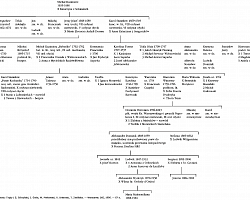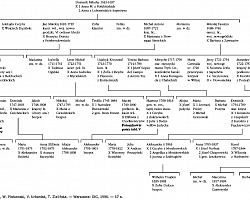History of Radziwills’ family
There was no family in the history of the Great Principality of Lithuania (below — GPL) which could be equal to the Radziwiłłs in the number of prominent political, clerical, military, and cultural figures. Its representatives twice took the highest, in the GPL church hierarchy, position of Archbishop of Viĺnia and, at a later date, one of them became Archbishop of Kraków and then a cardinal. 13 representatives of the family took the highest position of Voivode of Viĺnia during the 15th-18th centuries, 7 of them were State Chancellors and 6 of them were Great Hetmans. On the whole, 38 Radziwiłłs took the posts which gave them the right to be members of Great Princes’ Rada and, later on, of the Senate of Rzecz Pospolita. Barbara Radziwiłł became the Queen of Rzecz Pospolitain 1550. Like the majority of the aristocracy, the Radziwiłłs had a romantic legend about their origin, which had begun since the 13th century. Three branches sprang up from Mikołaj Radziwiłłowicz’s sons:
The first (the eldest) one, with the title of Prince on Goniądz (now Poland) and Miadzieĺ (Belarus) originated from his eldest son Mikołaj and declined along the male line in 1542 after the death of the last of his sons Jan Mikołaj, Starosta Zhemoitski. In connection with this, the title of Prince was forfeited by the Radziwiłłs. But very soon, the representatives of the other two branches achieved its rehabilitation in 1547. That oldest branch had nothing in common with the history of Niasvizh.
The second (youngest, in fact) branch later enjoyed the title of princes on Birża and Dubinki (Lithuania). It was also known as Birża branch. Its founder was an outstanding military commander Jerzy Radziwiłł (about 1480–1541) whose nickname was «Hercules Litowski», Castellan of Viĺnia and Hetman. That branch also declined along the motherly line in 1669 after the death of Prince Bogusław. his immense possessions In 1731 (finally in 1744), his immense possessions were added to the possessions of Niasvizh branch of the Radziwiłłs.
The third branch, with the prince title in Niasvizh (Belarus) and Olyka (the Ukraine) originated from Jan «Brodaty» (1474–1522), Castellan Trokski. That branch was furthermore divided into Ordinats of Niasvizh, Olyka, and Klietsk.
The story of how the Radziwiłłs got Niasvizh into their possession is as follows. In 1492, the Great Prince Alexander granted Niasvizh to Voivode Trokski Piotr Jan Montygerdowicz. In 1494, the latter passed away and his heritage was divided between his wife and daughter. Montygerdowicz’s widow got Olyka and its volost while the daughter who had married Voivode of Polack Stanisław Kiszka got Niasvizh with its surroundings. In 1513, the daughter of Stanisław and Anna Kishka married Jan Radziwiłł the Bearded and gave him her heritage — Niasvizh with its surroundings — as her dowry. Two sons were born in that marriage — Mikołaj and Jan — who got Niasvizh as heritage from their mother. After their father’s death, they stayed under the guardianship of their uncle Jerzy Radziwiłł. The youngest of the brothers Jan (1516–1551) died leaving no heirs. Following that, the only heir of Niasvizh became Mikołaj Radziwiłł the Black (04.02.1515 — 28.05.1565), one of the brightest representatives of his time.
During the four centuries, there were 17 Ordinats in Niasvizh.




